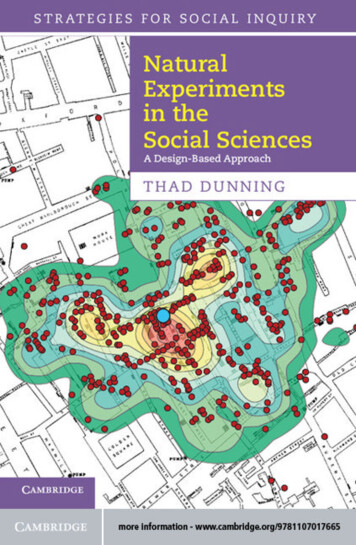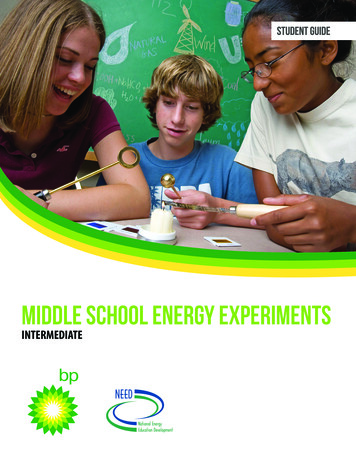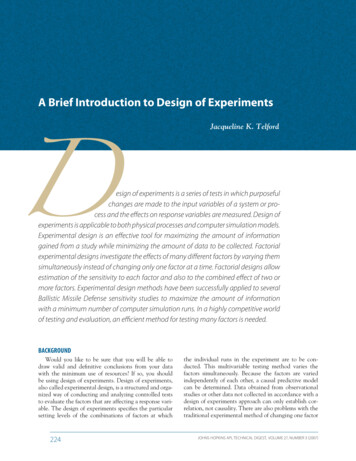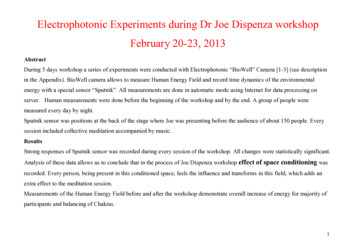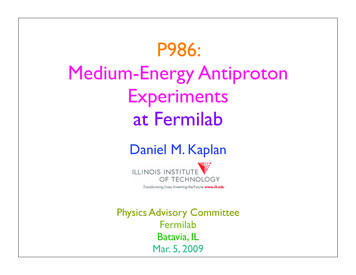
Transcription
P986:Medium-Energy AntiprotonExperimentsMuon Cooling and Future Muon Facilitiesat FermilabDanielM.M. KaplanKaplanDanielPhysics Advisory CommitteeFermilabBatavia,ILAccelerator Physicsand TechnologySeminarMar.Fermilab5, 200913 February, 2007
Outline(Varied menu!) D. M. Kaplan, IITAntiproton sourcesHyperon CP violationA new experimentIssues in charmoniumCharm mixingSummaryP986 Letter of IntentFNAL PAC 3/5/092
Antiproton Sources 2Fermilab Antiproton Source is world’s most intensehighest-energy)Table 1 (andAntiprotonenergies and intensities at existing and future facilities.FacilityCERN ADFNAL (Accumulator)FNAL (New Ring) FAIR ( ( 2015)2016)p K.E.(GeV)0.005, 0.047 3.5–82–20?2–15Stacking:Rate (1010 /hr)Duty 80 p/Yr(1013 )0.4171009 The lower number of operating hours at FAIR compared with that at other facilities arisesfrom medium-energy antiproton operation having to share time with other programs.2 PhysicsevenOverviewafterGSI FAIR turns on (has yet to breakground; will likely take some time to reach this goal)A number of intriguing recent discoveries can be elucidated at such a facility, foremostamong which is charm mixing [3]. The key question is whether there is new physics incharmmixing;the signature for thisP986is CPnewPACphysics3D. M. Kaplan,IITLetterviolationof Intent [4]. The search forFNAL3/5/09 inB and K mixing and decay has so far come up empty. Thus it behooves us to lookelsewhere as well. As pointed out by many authors, charm is an excellent venue for
Hyperon CP Violation B Factories have shown Bmixing & CPV dominantly SMworth looking elsewhere!RL-4101 0- 51 0- 41 0- 3D. M. Kaplan, IITLR1 0- 2 (ε'/ε)SUSY Leading potential signals are AΛ, AΞΛ, BΞ, ΔΩ:αΛ αΛβΛ βΛΓ Λ Pπ Γ Λ PπAΛ , BΛ , ΔΛ αΛ αΛΓ Λ Pπ Γ Λ PπβΛ βΛ Too large ε'/ε-1 0- 3World Average Differently sensitive to newphysics than B, ε′/ε (parityconserving interactions)complementary to mu2e A(Λ0 )SUSY G.Valencia, 2000excluded by ε for LR RL caseCP-oddp̅ source can produce 108 Ω– Ω ̅ ,& maybe 1010 Ξ– Ξ ̅ (transition crossing)P986 Letter of IntentFNAL PAC 3/5/094
Hyperon CP Violation SM predicts small CP asymmetries in hyperon decayNP can amplify them by orders of magnitude:Table 5: Summary of predicted hyperon CP asymmetries.Asymm.AΛAΞΛAΩΛ Ξπ ΛK ModeΛ pπΞ Λπ, Λ pπΩ ΛK, Λ pπΩ Ξ0 πΩ ΛKSM 5 10 4 0.5 10 4 10 52 10 5 1 10 5NP 4 6 10 1.9 10 3 8 10 3 2 10 4 1 10 3Ref.[68][69][36][35][36]Once they are taken into account, large final-state interactions may increase this prediction [56].Tandean and Valencia [35] have estimated Ξπ 2 10 5 in the standard model but5D. M. Kaplan,Letterof IntentFNAL PAC 3/5/09possiblyanIITorder of magnitude largerP986withnew-physicscontributions. Tandean[36] hasestimated ΛK to be 1 10 5 in the standard model but possibly as large as 1 10 3
HyperonCPViolationTheory & ExperimentTheory& experiment:TheoryTheory & Experiment–5Theoryet! al.]PRL 55, 162 (1985); PRD 34, 833 SM: [Donoghue, He, Pakvasa, Valencia, A .,10e.g.,AΛ 10–5–5 –3 (1986); PLB 272, 411 (1991)]Other models:canA beO(10) SM:Λ AΞΛ5 10 10–5 [J. Tandean, G. Valencia, Phys. Rev. D 67,[e.g. SUSY gluonic dipole: X.-G.He et al., PRD 61, 071701–3(2000)]056001 (2003)] Other models:O(10 d)![e.g. SUSY gluonic dipole: X.-G.He et al., PRD 61, 071701 (2000)][P. ChauvatChauvat etet al.,al., PLPL 163B163B (1985)(1985) 273]273][P.273[M.H. TixierTixier etet al.,al., PLPL B212B212 (1988)(1988) 523]523][M.H.273[P.D. BarnesBarnes etet al.,al., NPNP BB 56A56A (1997)(1997) 46]46]0.015[P.D.0.0060.006 – CP)(HyperCP)D. M. Kaplan, IIT% Λ!π&,,Λ! % ppπ&Ξ [K.B. LukLuk etet al.,al., PRLPRL 85,85, 48604860 (2000)](2000)][K.B.–4 [T. Holmstrom et al.,–4(0.0' 2 #6.7)–4# 10"10PRL 93. 262001 (2004)] 2 10–4[projected]# 10(6 '22 2) 10–4[BEACH08 preliminary]P986 Letter of IntentFNAL PAC 3/5/096
HyperonCPViolationTheory & ExperimentTheory& experiment:TheoryTheory & Experiment–5Theoryet! al.]PRL 55, 162 (1985); PRD 34, 833 SM: [Donoghue, He, Pakvasa, Valencia, A .,10e.g.,AΛ Measurements10–5–5 –3 (1986); PLB 272, 411 (1991)]PreviouscanAbe O(1010 )Other models: SM: AΞΛ Λ 5 10–5 [J. Tandean, G. Valencia, Phys. Rev. D 67,[e.g. SUSY gluonic dipole: X.-G.He et al., PRD 61, 071701–3(2000)]056001 (2003)] Other models:O(10 d)!Noneof X.-G.Hethe pre-HyperCP[e.g. SUSY gluonicdipole:et al., PRD 61, 071701 (2000)]experiments had thesensitivity to test theoryHyperCP probes well intoregions where BSMtheories predict nonzeroasymmetries[P. ChauvatChauvat etet al.,al., PLPL 163B163B (1985)(1985) 273]273][P.273[M.H. TixierTixier etet al.,al., PLPL B212B212 (1988)(1988) 523]523][M.H.273[P.D. BarnesBarnes etet al.,al., NPNP BB 56A56A (1997)(1997) 46]46]0.015[P.D.0.0060.006 – CP)(HyperCP)D. M. Kaplan, IIT% Λ!π&,,Λ! % ppπ&Ξ 27 June 2008[K.B. LukLuk etet al.,al., PRLPRL 85,85, 48604860 (2000)](2000)][K.B.–4 [T. Holmstrom et al.,–4(0.0' 2 #6.7)–4# 10"10PRL 93. 262001 (2004)] 2 10–4[projected]# 10(6 '22 2) 10–4[BEACH08 preliminary]Chad J MaterniakP986 Letter of Intent13FNAL PAC 3/5/096
(fromfarm histos):EnormousHyperCPDatasetMade possible by. Results D. M. Kaplan, IITp̅ source can produce 108 Ω– Ω ̅ /y & maybe 1010 Ξ– Ξ ̅P986 Letter of IntentFNAL PAC 3/5/097
mass for the 3" hypothesis was required to be outside 10 MeV c2 of the K " mass. The cuts on 2 ndf,DCA, and the total momentum were the same as for theHyperCP also 1010 Σ –Σ pµ µ Decay 2.4σ fluctuation of SM? or-SUSY Sgoldstino?SUSY light Higgs?week ending23FEBRUARY2007FIG. 5. The reconstructed pe e mass distribution for thenormalization mode after all cuts. The histogram is the sum of"FIG. 4. Real (points) and MC (histogram) dimuon mass disMC samples of !"pee# , K"ee# decays and a uniform background,!! ""eventsnormalization)with fortributions for (a) !p!! MCDoesthe(arbitraryHyperCPEvidencethetheDecay! !ofp!! determinedIndicateby a fit, andwhererelative amountseach werea form-factor decay (solid histogram) and uniformphase-spacethe numberof MC Boson?events was normalized to match the numbera Light PseudoscalarHiggsMCeventsdecay (dashed histogram) model, and (b) !"ofdataevents.Thehatched area shows the main backgroundpP!!normalized to match the data.source (uniform* background).PRL 98, 081802 (2007)PHYSICAL REVIEW LETTERS" #Xiao-Gang He021801-3Sciences, National Taiwan University, Taipei, TaiwanDepartment of Physics and Center for TheoreticalJusak Tandean†Departments of Mathematics, Physics, and Computer Science, University of La Verne, La Verne, California 91750, USAG. Valencia‡Department of Physics and Astronomy, Iowa State University, Ames, Iowa 50011, USA(Received 2 November 2006; published 22 February 2007)The HyperCP Collaboration has observed three events for the decay !! ! p!! !" which may beinterpreted as a new particle of mass 214.3 MeV. However, existing data from kaon and B-meson decaysprovide stringent constraints on the construction of models that support this interpretation. In this Letterwe show that the ‘‘HyperCP particle’’ can be identified with the light pseudoscalar Higgs boson in thenext-to-minimal supersymmetric standard model, the A01 . In this model there are regions of parameterspace where the A01 can satisfy all the existing constraints from kaon and B-meson decays and mediate!! ! p!! !" at a level consistent with the HyperCP observation.D. M. Kaplan, IITDOI: 10.1103/PhysRevLett.98.081802P986 Letter of IntentThree events for the decay mode !! ! p!! !" with aFNAL PAC 3/5/09PACS numbers: 14.80.Cp, 12.60.Jv, 13.30.Ce, 14.20.Jn8also been shown [7] that a light sgoldstino is a viable
How Follow Up?One possibility: Return Yoke?!2T solenoidBarrel calor.targetp beamOnce Tevatron shuts down ( 2010),—-TOF SciFi Sci TOF FiSiPix SiPixReinstall E835 EM spectrometerBarrel calor.Add small magnetic spectrometer!2 mFigure 4: Sketch of pp spectrometer dAdd precision TOF system 10MAdd wire or pellet targetaAdd 2ndary-vertex triggerRun pp̅ 5.4 GeV/c (2mΩ s̅ 2mΩ mπ )Detector ideas & moreD. M. Kaplan, IIT32-2-1@ L 10 cm s (10 E835)}Figure 6: E835 apparatus layout (from [60 108 Ω Ω ̅ /yrD. M. Kaplan, IIT 1012 inclusive hyperon events!P986 Letter of IntentPAC 3/5/09 9Figure 5: Dimuon mass spectrum FNALof thethree HyperCcompared with Monte Carlo spectrum assuming (a) sta
What Can This Do? Observe many more Σ pµ µ events andconfirm or refute SUSY interpretation Discover or limit Ω Ξ µ µ and confirm orrefute SUSY interpretationPredicted B 10–6 if P0 realDiscover or limit CP violation in Ω ΛK and Ω Ξ0 π via partial-rate asymmetriesPredicted B 10–5in SM, 10–3 if NPD. M. Kaplan, IITP986 Letter of IntentFNAL PAC 3/5/0910
What Else Can This Do?Much interest lately in new states observed incharmonium region: X(3872), X(3940), Y(3940),Y(4260), and Z(3930)X(3872) of particular interest: may be the firstmeson-antimeson (D0 D̅*0 c.c.) molecule (ortetraquark or what?)very precise mass & width measurement to needconfirm or refute pp X(3872) formation ideal for this Also hc mass & width, χc radiative-decay angulardistributions, ηc’ full and radiative widths,.D. M. Kaplan, IITP986 Letter of IntentFNAL PAC 3/5/0911
Example: precision p̅p mass& width measurementsE760 χc scans σm (beam) 0.5 MeV/c2{The beam is the spectrometer! δm(χc) 0.1 0.02 MeV/c2δΓ(χc) 0.1 0.01 MeV/c2The experiment is just the detector.D. M. Kaplan, IITP986 Letter of IntentFNAL PAC 3/5/0912
Example: precision p̅p mass& width measurements78 Fermilab E835 Collaboration / Physics Letters B 654 (2007) 74–79Andreotti et al.,PLB654 (2007) 74Works even for ψ′:-E835 measuredΓ (290 25 4) keVwith 2,700 events-used “complementary scans”to reduce systematicsFig. 1. Γ dependence on η for stacks 1 and 29, and from their combination,when the phase-slip factor is a fixed parameter. The result of the global fitwith free η is represented by the cross. The value of the phase-slip factor fromthe synchrotron-frequency measurement (vertical line) and its uncertainty (grayband) are also shown.Best technique for X(3872)mass & (sub-MeV?) widthmeasurement5. ResultsD. M. Kaplan, IITBoth channels in both scans are fitted simultaneously, leaving the phase-slip factor as a free parameter. The energy distributions are rescaled according to Eq. (7) for the ‘constantorbit’ scan and Eqs. (7) and (8) for the!‘constant-field’ scan.eeThe log-likelihood function is log(Λ) i [log P (µeei , Ni ) XXlog P (µi , Ni )]. For each channel, the mean numbers of eventsXµeei and µi are evaluated according to Eq. (1). We monitor the efficiency of each data run and the efficiencies varyless than 0.4% over a single scan.BothLetterscans havesameP986of theIntente e efficiency ε ee 0.413 0.015. For the J /ψ X chanX 0.402 0.011;nel, the constant-field scan efficiency is εcfdifferences in detection efficiency between the two scans areaccounted for by the parameter (εX /ε X ). They are due to aFig. 2. ψ(2S) resonance scans: the observed cross section for each channel(filled dots); the expected cross section from the fit (open diamonds); the ‘bare’resonance curves σBW from the fit (solid lines). The two bottom plots show thenormalized energy distributions Bi .FNAL PAC 3/5/09the resonance width narrower. The BPM noise is evaluatedfrom portions of runs with no energy drifts and its standard13
What Else Can This Do?D. M. Kaplan, IITP986 Letter of IntentFNAL PAC 3/5/0914
Charm? Braaten estimate of p̅pX(3872) couplingassuming D*Dmolecule D. M. Kaplan, IITP986 Letter of Intentextrapolates fromK*K dataBy-product is D*0D̅0cross sectionFNAL PAC 3/5/0914
Charm? D*D̅ cross-section estimate (after E.Braaten, arXiv:0711.1854)PRD 77, 034019)(Expect good to factor 3)-1.401.20sigma (µb)1.000.800.600.400.200.003.544.55 sD. M. Kaplan, IITBraaten estimate of p̅pX(3872) couplingassuming D*DmoleculeP986 Letter of Intentextrapolates fromK*K data By-product is D*0D̅0cross section 1.3 µb 5 109/yearExpect efficiency as atB factoriesFNAL PAC 3/5/0914
D0’s mix! (c is only up-type quark that can)Big question:New Physics or old?y (%) Charm? HFAG-charm2ICHEP 2008CPV 2x (%)D. M. Kaplan, IITP986 Letter of IntentFNAL PAC 3/5/091532
D0’s mix! (c is only up-type quark that can)Big question:Singly Cabibbo-supressed (CS) D decayshave 2 competing diagrams:NewW Physics or old?y (%) Charm? HFAG-charmICHEP 20082 a)cs1.5K uW 1cu00.5 D0-0.5d,s,bK4!5!-1uD0s –Kuuu1 !2 !K s3 !c-1D. M. Kaplan, IITu-0.50g,!,Z 10.51.52s B factories have 109open-charm events p̅p can produce 10 /ybest sensitivity world’sto charm CPV10Kx (%)uKkeyd,s,b is CP Violation!sPossiblein CF, DCSg,!,ZsKonly if New Physicsuu–W D0s –Kuσ8.9b)s b)CPV allowed–P986 Letter of IntentFNAL PAC 3/5/091532
Charm?(a) D0 K K-Events per 0.1MeVEvents per 1MeV/c4H.E. fixed-target)10 321.8210 51.841.86(b) D0 K-π Assumes 15% of running time is devoted to antiproton-beam stacking.410Compare with 1.22 x 106 tagged events atReferencesBelle[M. Staric et al., PRL 98, 211803 (2007) ]1031021.8401031002M (GeV/c )Belle540 fb–11.861.880.06(e0.04 -FNAL PAC 3/5/09[4] See 08/results mix cpv.htmland E. Barberio et al., arXiv:0808.1297 [hep-ex].21.902M (GeV/c )LHCbwillet havebut diff’t[2] M. Starical. [BellecomparableCollaboration], Phys.statisticsRev. Let. 98, 211803(2007). systematics(c) D π π(2001)and references therein.D. M. Kaplan, IIT [3] See e.g. D. M. Kaplan, hep-ex/0111044P986 Letterof Intent1.910 20.021.82[1] E. Braaten, Phys. Rev. D 77, 034019 (2008).1.8810 31/N dN/dσt102(d10 4τKπ (fs) 102 2 107s/y0.8*2 1032cm 2 s 1272.6 (known from1.25µb102.1 10events/y0.6770.03890.5(signal MC)0.1(see below)72.7 10events/yEvents per 1MeV/cRunning timeDuty factorLTarget AA0.29σ(pp D X)# D producedB(D D0 π )B(D0 K π )AcceptanceEfficiencyTotal2 ents per 1MeV/c the !s determines the flavor of themeson. Each track is required to havated vertex detector hits in each ocoordinates. To select pion and kaopose standard particle identificatiodaughter tracks are refitted to a comD( 0 productionvertex is found by con)Table 2: Assumed values and sensitivity-benchmark estimate of tagged D 0 K π tum vector and the !s track to origevents per year. (Caveats: As discussed in text, the reliability of some of these valuesinteractionregion; confidence s to besensitivityestablished. Theyare based onexclusivecross-sectionestimates,so the onrequiredfor orboth fits. A D! mominclusive production rate nosity,Braatenp̅palso D*0D̅0 formula and assuming σA1.0(in: the c.m.) is required2:5 GeV cefficiency couldbe lower.)produced in B-meson decays and toQuantityValueUnitrial background. The proper decay t164204154104050(f)W.
Charm? D. M. Kaplan, IITAnother possibility (E. Braaten): use theX(3872) as a pure source of D*0D̅0 events-the p̅p equivalent of the ψ(3770)!?-comparable to BES-III statisticsassuming current Antiproton Accumulatorparameters ( p/p) & Braaten estimate,produce 108 events/yearcould gain factor 5 via AA e– cooling?Proposed expt will establish feasibility & reachP986 Letter of IntentFNAL PAC 3/5/0917
Background Study How efficiently can we identify D* D0 decayswhile adequately suppressing background? Study via MIPP 20 GeV p̅p data:mD0MIPP 20 GeV p̅p(h h–h and h–h h–comb’s w/ pt1 pt2,pt3)(GeV)D*,D masswindowD. M. Kaplan, IITP986 Letter of IntentmD* (GeV)1st-ordercorrection forhigher beamenergy:pz 0.65pz(conservative)FNAL PAC 3/5/0918
Background StudyCut on D* and D masses and D*–D mass difference:# events All combinationsSignalbinmD* – mD (GeV) Combinations inD*,D mass windowmD* – mD (GeV)Leaves only 1 background event – with no kaon ID!D. M. Kaplan, IITP986 Letter of IntentFNAL PAC 3/5/0919
Background Study MIPP normalization @ 20 GeV not yet workedthrough in detail, but sample sensitivity 1 evt/µb Suppose total inclusive σ(D*) 10 µb (incl. A-dep.)x B: 0.67 x 0.039 1/4 evt signal sig/bkg 0.1 (with above D*–D cuts)Kaon ID x 10Lifetime cuts x 10 –100Clean sample can likely be obtained withreasonable ( 0.1) efficiencyD. M. Kaplan, IITP986 Letter of IntentFNAL PAC 3/5/0920
Summary Best experiment ever on hyperons, charm, andcharmonia may soon be feasible at Fermilab-including world’s most sensitive charm CPV study?Mix of speculative and established physics goals-for some, feasibility depends on poorly knowncross sectionswe can measure them quickly and cost-effectivelyno modification of accelerator complex requiredWorld’s best p̅ source simple way to broadphysics program in (pre-)Project X eraD. M. Kaplan, IITP986 Letter of IntentFNAL PAC 3/5/0921
th0 -orderrun-plan example:install/debug 3 mofind X(3872) 1 momeasure σ(D*) 1 momeasure σ(ΩΩ̅) 1 mocharmonium 3 moX(3872) run 12 mohyperon CP run 12 moinstall/debug hadron-ID upgrade 3 mocharm CP run 12 mo}if σ’s favorableOur request:encouragement from Directorate to continuesimulation, design, & planning studies & developproposal-D. M. Kaplan, IITP986 Letter of IntentFNAL PAC 3/5/0922
International Aspect Potential European interest (e.g. PANDA)-opportunity for early data & experience Could significantly reduce needed US resources But recent US HEP events cautionary need indication of US interest to beginnegotiationD. M. Kaplan, IITP986 Letter of IntentFNAL PAC 3/5/0923
Background StudyChuck Brown chuckb@fnal.gov RE: Easy simulation?March 4, 2009 11:17:04 AM CST'Daniel Kaplan' kaplan@iit.edu MC comparison ofD0The answer is, for 20,000 D0 decays where Ebeam 8.937, the pi K within .1 atan(theta) 1.0, and the vertex resolution is taken as 100 mfor both the D and the 20,000 background events that have D- Kpi kbut z 0.: Kπ signal & prompt background10,000 evts eachvtx Backgroundcut #bkgremaining #sigsig/bkg ratioD D*,DD's remainingaccept.acceptanceNo cut on z10,000z 100 microns1,589z 200 microns238z 300 microns14z 400 5018% 1000 13%- ChuckB-----Original Message----From: Daniel Kaplan [mailto:kaplan@iit.edu]Sent: Tuesday, March 03, 2009 7:52 AMTo: Chuck BrownSubject: Re: Easy simulation?.or maybe it's a back-of-the-envelope theorem and no MC needed?try to find time to work on this.DanOn Mar 3, 2009, at 6:56 AM, Daniel Kaplan wrote:D. M. Kaplan, IITP986 Letter ofHiIntentChuck,FNAL PAC 3/5/0924Are you able to attend today's noon phone conference? Your i
7FAIR-ESAC/Pbar/Technical Progress Report, January 17, 2005TOF stopP̅ANDAhadron calorimeterTOF stopMUOsolenoidii22DIRCoPANDA - Strong interaction studies withantiprotonsMUO140TOF stopo140beamUniversität Basel, SwitzerlandSTT orTPC F. ZehrM. Kotulla,B. Krusche,TOF DIRCstopiiiivPANDA - Strong interaction studies with antiprotonsMDCINFN-Laboratori Nazionali di Frascati, ItalyP. Gianotti, C. Guaraldo, O.N. Hartmann, M. Iliescu, V. Lucherini, E. Pace, C. Petrascu, D. Sirghi,RICHF. Sirghio10 o22hadron calorimeterodipoleEMCDIRCTOF stopFAIR-ESAC/Pbar/Technical Progress Report, January 17, 2005coilsolenoidThe PANDAEMCCollaborationMDCINFN, Sezionedi Genova, ItalyMDCR. Ballantini, M. Macri, R. Parodi, A. PozzoorJustus Liebig-Universität Gießen, II. Physikalisches Institut, GermanyKungliga Tekniska Högskolan (KTH), Stockholm, SwedenEMCB. Cederwall, A. JohnsonStockholms Universitet, SwedenC. Bargholtz, K. Lindberg, P.E. Tegnér, I. ZartovaUniversità del Piemonte Orientale Alessandria, Torino and INFN, Sezione di Torino, ItalyM.L. Colantoni, L. Fava, D. PanzieriW. Döring, P. Drexler, M. Düren,I
Daniel M. Kaplan Physics Advisory Committee Fermilab Batavia, IL Mar. 5, 2009 Muon Cooling and Future Muon Facilities Daniel M. Kaplan . The competition for this program is a pos
